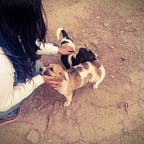ON ARTISTS
Vulnerability of Artists
It cuts both ways
There’s something to be said about the audacious truthfulness that any genuine, momentous art contains within itself.
Cause And Effect, a poem by Charles Bukowski -
the best often die by their own hand
just to get away,
and those left behind
can never quite understand
why anybody
would ever want to
get away
from
them
With different media, the appreciatory audit differs.
But the impact is always the same — art is anything that is able to invoke intimate, echt emotions in the observer.
It is a meeting of two eternities, the artist’s and the observer’s psyches.
I’ve once quoted Neil Gaiman in a previous note:
The moment that you feel, just possibly, you are walking down the street naked, exposing too much of your heart and your mind, and what exists on the inside, showing too much of yourself… That is the moment, you might be starting to get it right.
and Hemingway in his classic style:
There is nothing to writing. All you do is sit down at a typewriter and bleed.
As I read and write more than I draw or dance, these above speak directly to me.
As a novice writer who flinches regularly while revising Vonnegut’s advice on writing, I will attest to the naked and bleeding part.
Art exposes artist’s inherent vulnerability, and its veracity when reflected against the artist’s worldview offers the observer the artist’s honest admission of character.
And this apparent chink in the artist’s armor, is what pores out wild and surreal yet factual feasts of others’ character analyses. More specifically, that of the ones one knows.
Think about it. It’s impossible for a true Artist to relay anything that doesn’t speak their truths. And on top of that, they cannot measure their work’s worth on any random scale.
Kafka was so frustrated as a mechanical cog in office routine that his art forced us to invent the word ‘Kafkaesque’ to describe a metaphor for dreary and disturbing bureaucratic mazes. Nothing other than inspired illuminating of the human condition could move us so much. We appreciate those who help us become braver in our approach to the uproarious juggernaut that is life.
And I wonder how many of us know what it feels like to be a nobody, rather a nothing, in our lifetimes. Kafka’s angst is palpable to us across space and time, because the basic characteristics of humans have stayed unchanged for the timeline of this species. We have all metamorphosed a few times.
Do I think Kafka was happy with his quality of work? I don’t think that he had the mindset to think about it with as much ardor with which he wanted to tell his story. You want to debate whether Nietzsche felt ecstatic about his seminal body of work right until he went mad? I don’t think he cared about what the world thought about his work and whether or not they benefited from it. I think he waded so deep into pondering about what it means to be human and to be alive, that he didn’t even gather the time to think about subjects like adulation.
And so it goes.
It cuts both ways.
On a lighter note, consider Shonda Rhimes’s smug declaration in a TV series —
It has been said that, of all bitches dead and alive, a scribbling woman is the most canine.
And an artist of a different medium, John Singer Sargent, resonating the collateral effect:
Every time I paint a portrait I lose a friend.
To conclude, I shall draw a parallel between arts and the art.
The Artist of the art that I sense omnipresent, even within me, is anonymous.
What is exhilarating is that — that the gravity of this sublime art is a force to reckon with is instantaneously translated to a mere humble observer like me — is the simplest, and clearest possible indicator of the heavenly nature of that Art.
Ever since we discovered that Earth is round and turns like a mad spinning-top, we have understood that reality is not as it appears to us: every time we glimpse a new aspect of it, it is a deeply emotional experience.
— Carlo Rovelli, Seven Brief Lessons on Physics
What does the art around me tell me about the character of its creator?
And what does my interpretation of it testify about my own character?
A mote of dust is a Bohemian gardener, a wildlife watcher, and a student of the Arts. Subscribe.
